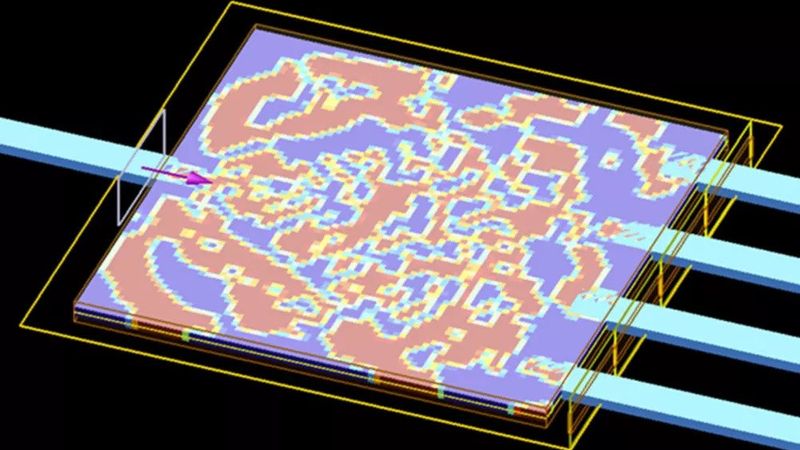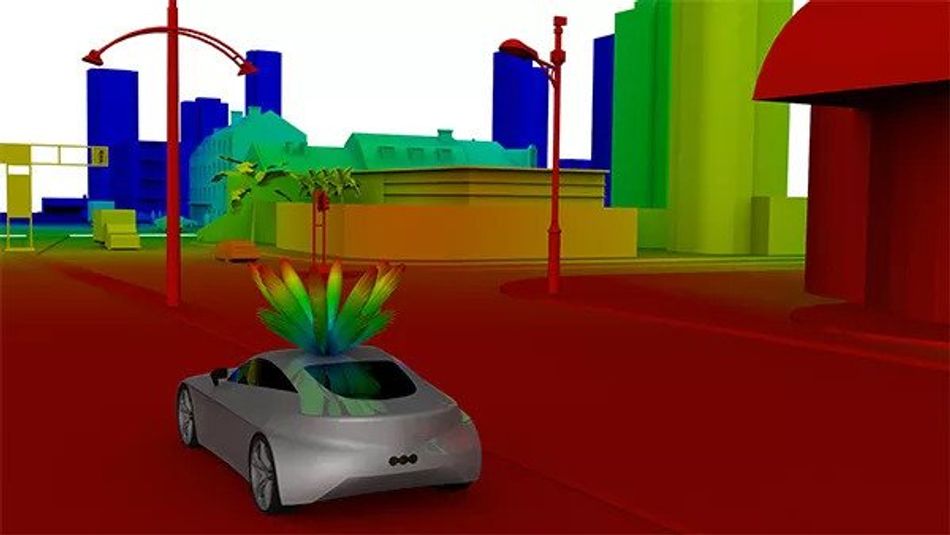Simulation accelerates the development of Photonic Integrated Circuits for automotive applications
Next-gen simulation tools accelerate innovation for Integrated Photonic automotive applications.

Image credit: Ansys
Together with Ansys, a developer of simulation software, we are creating a series of content about the technologies that make sustainable transportation possible. Read the foundation article of the series here, and our introduction to the Indy Autonomous Challenge here.
Integrated Photonics (IP) is the use of light for applications traditionally tackled by electronics. IP can be used in telecommunications, medical applications, and automotive applications. IP integrates multiple photonic functions on a Photonic Integrated Circuit (PIC) fabricated using automated wafer-scale generic integration technology over silicon, silica, or Indium Phosphide (InP) substrates. Complex photonic integrated circuits can generate, process, and detect light, in analogy to how electronic integrated circuits do for electronic signals by way of connecting multiple discrete single-function components and relevant optical interfaces.
Complex systems require advanced methods of design support
PICs have undergone a dramatic increase in complexity in recent years, with the number of photonic components integrated on a single chip continuously increasing.[1] Microelectronics reached this milestone of integration over 40 years ago with the emergence of the first analysis programs for electronic circuits (ECs). In a similar way, software tools enabling the automated design process and testing for PICs are now an important prerequisite for increasing the number of integrated elements per chip, lowering their production costs, and broadening their application reach.

Delivering Photonic Circuit Simulation
PIC design comes with unique challenges, including layout, error checking, and circuit modeling. While electronic designers use a traditional electronic design automation (EDA) flow, standard EDA flows simply aren’t equipped to integrate photonics circuits and components into their electronic counterparts reliably or effectively. There is a multitude of simulation options available for PIC designers and engineers. The unique requirements of the sector have spurred several open source[2] or low-cost software projects in addition to significant investment from leading simulation companies. The complexity of PICs continues to be a challenge for simulation software developers who have to address both amplitude and phase modulation in each component, which makes it very difficult to predict the behavior of large circuits with many components due to interference effects. Specialized and specific PIC simulation software allows the design of photonic components, circuits, and systems and enables modeling of the interaction between optical, electrical, and thermal effects.
Photonic Integrated Circuits for Automotive applications
As the amount of electronic content in cars continues to increase the potential for PIC also rises rapidly. There is a wide range of applications within both fully electric and increasingly electrified ICE motor vehicles suitable for PIC. PICs have the potential to be a crucial element that enables electric and electric autonomous cars to become ubiquitous. Just as with automotive design discussed in previous articles in this series, simulation software plays a vital role in designing PICs and the systems they are a part of.
Integrated simulation for accurate LIDAR design
All self-driving vehicles require various sensors to form a perception of their surroundings and navigate to the destination. These sensors act as the eyes and ears for automobiles. LIDAR (Light Detection and Ranging) is a leading choice for many manufacturers.
The circuitry of LIDAR is exceptionally complex. Both the sensing photonics and controlling electronics need to be developed with meticulous care. Like many other ADAS technologies, LIDAR systems will likely incorporate PIC into future designs, enabling faster, lower cost, and smaller circuits to be deployed. Simulation plays a vital role in developing and testing LIDAR technology. However, for LIDAR systems that use PICs, simulation of just the LIDAR module is not enough to ensure the device’s optimum performance.

Using specialized integrated photonic simulations, engineers can assess the performance of the emitting laser, as well as the nanoscale integrated phased array (or liquid crystal) used to form and steer the beam. The laser beam propagation and its interaction with the environment are then modeled using macroscopic optical simulation technology. Then, engineers can model how the integrated sensor receives the laser signal calculated from the macroscopic optical simulation.
In the past, when simulating LIDAR systems, users needed to acquire integrated photonic information from measurements or vendors, but in recently launched simulation packages, this data is already integrated, assisting engineers to create high-fidelity simulations that can help them optimize source and detector designs. Additionally, various foundries have also partnered with simulation developers to provide engineers with high-quality photonic process design kits (PDKs). As a result, engineers can simulate and characterize a full electro-optical communication or sensing system.
Conclusion
PICs will herald a new era of exponential innovation with a significant impact on the automotive sector. Simulation tools will play a vital role in the automotive industry to rapidly conceptualize, test, and implement the upcoming technologies powered by Integrated Photonics. Advanced simulation packages that provide complex data suites and integration with foundries will assist in the rapid development of essential technologies such as LIDAR, critical to a decarbonized transportation future.
About the sponsor: Ansys
Through the extensive range of simulation software, Ansys enables innovators to take over challenging problems in engineering. In the automotive sector, simulation of battery management systems, electric motors, structural assemblies, advanced embedded software, electronic chips, networks, sensors, and a lot more is made simple by Ansys.
Ansys Lumerical is an advanced photonics simulation suite that enables engineers to model the most challenging problems in photonics. The software is an all-in-one solution for carrying out the device and system-level simulations. Ansys Lumerical also comes with scripting support and can interface with popular third-party applications like MATLAB and Python for numerical analysis, visualization, and optimization. With Ansys, it is possible to exponentially innovate and engineer what’s ahead in the automobile industry.
References:
1. Smit M, van der Tol J, Hill M. Moore's law in photonics. Laser & Photonics Reviews. 2011;6(1):1-13.
2. Ploeg S, Gunther H, Camacho R. Simphony: An Open-Source Photonic Integrated Circuit Simulation Framework. Computing in Science & Engineering. 2021;23(1):65-74.

